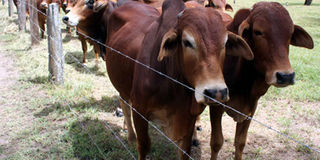Understanding brucellosis and how to curb the disease

Sahiwal cattle. Brucellosis is a highly contagious zoonotic disease that affects ruminants like cattle, goats and sheep and other animals including world life species and can also be transmitted to humans. FILE PHOTO | NMG
What you need to know:
- In humans Brucella abortus causes undulant fever, an occupational disease of people working with animals such as veterinarians, farmers and abattoir personnel.
- The disease is caused by bacteria called Brucella, which thrives and multiplies well in the reproductive organs of animals.
- Brucellosis in cows is very difficult to diagnose. The best indicators are abortion or the birth of weak calves and a drop in milk production.
- To completely eradicate Brucellosis from a herd, there is need to test the animals and eliminate those that test positive.
Brucellosis is a highly contagious zoonotic disease that primarily affects animals, but can be transmitted to humans.
The disease is caused by bacteria called Brucella, which thrives and multiplies well in the reproductive organs of animals.
Brucellosis infects ruminants like cattle, goats and sheep and other animals including world life species.
In humans Brucella abortus causes undulant fever, an occupational disease of people working with animals such as veterinarians, farmers and abattoir personnel.
There are several strains of Brucella that affects different animals and they include:
• Brucella abortus: Affects cattle, causing bovine brucellosis (contagious abortion). Sometimes it affects horses, causing fistulous withers.
• Brucella ovis: Affects sheep, causing ovine brucellosis.
• Brucella melintensis: Mainly affects female goats, causing caprine brucellosis. It can also affect female sheep.
• Brucella suis: Affects pigs, causing swine brucellosis. It has also been isolated from horses.
• Brucella canis: Affects dogs, causing canine brucellosis.
The disease is transmitted through contact with fluids from aborted foetus, placenta and uterine discharge, ingestion of placenta contaminated with Brucella, other cows licking new born calves from infected dams or licking the genital area of other infected cows and through venereal transmission and artificial insemination with semen from infected bulls.
Infections also come through ingestion of contaminated feeds and drinking water.
Humans acquire infections through ingestion of contaminated raw milk and skin contact with fluids from the uterus of infected cows.
Cattle show the following symptoms of brucellosis:
• Abortion storm (at 5-7 months of pregnancy).
• Still births.
• Some cows will give birth to weak calves.
• Drop in milk production.
• Infertility.
• Weight loss.
• Retained placenta.
• Enlarged arthritic joints.
• Orchitis (inflammation of the testicles) in bulls.
Infected cows will continue to shed bacteria through the vaginal fluid discharge until after parturition when the discharge stops.
Some infected cows that had previously aborted will shed the bacteria after other subsequent normal parturition as they remain carriers and continue to have reproductive problems.
Brucellosis in cows is very difficult to diagnose. The best indicators are abortion or the birth of weak calves and a drop in milk production.
Infected cows will abort between the 5th and 7th months of pregnancy though not all infected cows abort.
Blood and milk samples from each quarter and vaginal swabs from infected cows should be collected and taken to the lab for analysis and diagnosis.
Treatment
There is no specific treatment for animals with brucellosis. The disease is managed in human.
Prevention
Brucellosis is prevented through vaccination. Heifer calves should be vaccinated with S19 vaccine between 2-4 months of age.
To completely eradicate Brucellosis from a herd, there is need to test the animals and eliminate those that test positive.
Any new bull that is meant for serving cows should be tested for Brucellosis
Any new animal introduced into the herd should be from a Brucellosis free herd and should be isolated for 30 days before joining the herd.
Humans should not consume undercooked meat or unpasteurised dairy products like milk and ice cream.
People who handle animal tissues should protect themselves by using: rubber gloves, gowns or aprons





